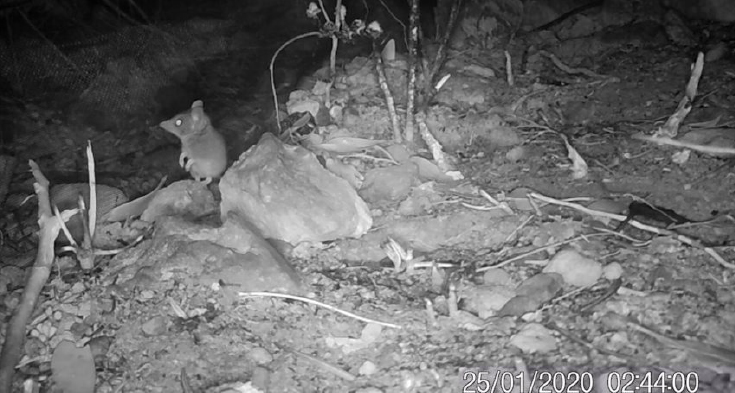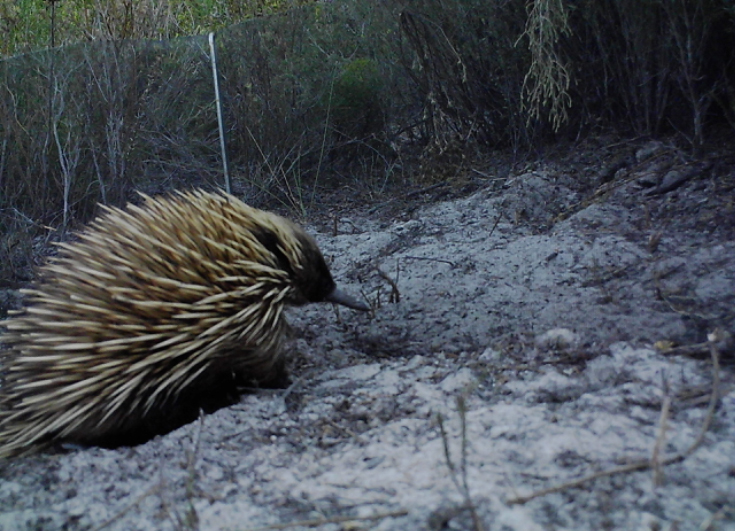Wildlife experts find hope among the ashes on Kangaroo Island
Signs that rare bird and marsupial colonies are surviving the aftermath of horrific bushfires are emerging with the help of sensor cameras, water pumps and specialist ecologists.
Sightings of tiny dunnarts using motion-sensing cameras are particularly heartening after fears habitat destruction would decimate the threatened nocturnal marsupials already only numbering between 300 and 500.
Fires burned about 200,000 hectares of land, almost half the island, and especially the protected areas in which dunnarts are found.
South Australia’s chief ecologist at the Department for Environment and Water Dr Dan Rogers said specialist advice from some of the world’s leading experts in the rare species was helping. “Prof Chris Dickman, he knows more about dunnarts generally than anyone else in the world, he was on the phone to us talking us through the biggest risk during the fire and immediately after,” Rogers said.

The rare Kangaroo Island dunnart has been captured on wildlife cameras by the non-governmental organisation Kangaroo Island Land for Wildlife
“After the fire the dunnarts that survived were being found in relatively high densities in unburnt patches and we thought they would be honey pots for the remaining cats on the island… we tried to reduce the risk from the cats.”
Now, the mouse-like creatures that have a pouch like a kangaroo for their babies and are related to quolls and Tasmanian devils, are looking safer. “They have got a lot of fight for their size,” Dr Rogers commented.
More than 90 per cent of the dunnart’s habitat was burned and the non-governmental organisation Kangaroo Island Land for Wildlife is working with landowners and National Parks and Wildlife Service South Australia to monitor the threatened species.
About 50 motion-sensing cameras are set up in 10 of the larger unburnt patches of parkland and the Australian Wildlife Conservancy has funded a cat-proof fence around one dunnart population on private land on the west coast of Kangaroo Island.
Early work to use aeration pumps to mimic water movement and improve circulation also appears to have helped save the only platypus habitat on the island in the burned Rocky River region of the Flinders Chase National Park.
The rare duck-billed semi-aquatic mammals survived the fire that destroyed vegetation along with the nearby visitor centre, housing and campground.
Fears ash and soil runoff from land denuded of vegetation would rob their pond of oxygen were quickly addressed.
“We installed the pumps before two days of rain, a lot of ash went into the pond but the platypus survived that with the pumps providing benefits,” Rogers explained. He said volunteer support and donations from around the world to protect wildlife had been overwhelming, even actors like Jamie Foxx in the United States fundraised for Kangaroo Island wildlife: “Some of these species people around the world have never even heard about and suddenly people are donating to help them, the profile of threatened species throughout the bushfires has been remarkable.
“There are many species on Kangaroo Island found elsewhere in the country but because they have been isolated they have their own unique forms.”
Rogers said COVID-19 had not disrupted the remote work at this stage, but would be continually reassessed as guidelines came into play, with the main issue being people travelling to and from the island.
One of the most heart-warming images for Rogers occurred during a walk through the charred and lifeless fire ground a few weeks ago. “An echidna comes trundling around out there just getting on with its business,” he said.
It was particularly positive to see the endangered short-beaked echidna was still surviving on the blackened grounds where there was little sign of life. Rogers noted that despite the creatures being slow moving they were resourceful, many burrowed underground or sheltered under logs to survive the flames – their favourite food, termites and ants, seemed to have survived in a similar fashion.

Longer, thinner and paler spines set the KI echidnas apart from their mainland Australia cousins (image: Kangaroo Island Land for Wildlife)
It is estimated that 4,000 to 6,000 of the unique echidnas were living on the island before the fire but about 50 per cent of their habitat was burned. This special subspecies has longer, thinner and paler coloured spines than echidnas found elsewhere on mainland Australia.
Kangaroo Island is also home to an important population of koalas which, because of their isolation, have remained free of the Chlamydia infection plaguing mainland populations. Before the bushfires there was an estimated 50,000 koalas living on the island but now early estimations put that figure at between 5000 and 10,000.
Much work has been done to support the Chlamydia-free population in a partnership between Kangaroo Island’s Hanson Bay Wildlife Sanctuary and Adelaide’s Cleland Wildlife Park.
About 30 rescued koalas are now at Cleland near the state’s capital city of Adelaide to prevent them from starving and to help build a disease-free population on mainland South Australia.
Careful monitoring of the island’s many rare birds is also continuing.
“We found Kangaroo Island Emu-wren in a patch of unburned vegetation, that number went down from 20 to six in a week, we thought if we don’t move them these birds will all be gone in a month,” Rogers said. Adelaide Zoo and Birdlife Australia moved the birds to a larger patch “and we think they are doing OK now," he continued. “Those Mallee habitats are well adapted to fires in a general sense, but we are concerned about the scale of this fire.”
Other work is under way, with assessment surveys of native animals and a longer-term Wildlife and Habitat Bushfire Recovery Plan. “Typically, native vegetation springs back well,” Dr Rogers said.
“It is pretty amazing to see how the country was starting to green up, the Yakkas are sprouting up again, they have large, underground tubers.
“Their flower spikes are coming up over the next few months which is so important for honeyeaters (birds) and butterflies that rely on their nectar and pollen, and bees, they will pretty much be the only thing flowering on that landscape.”
https://youtu.be/ExBsPEgQ-mQ
Republished under CC License, contributor: Belinda Willis, The Lead. Read CRJ's analyses of the Australian Bushfires in our latest edition
Thumbnail image: Serafina Manekina/123rf